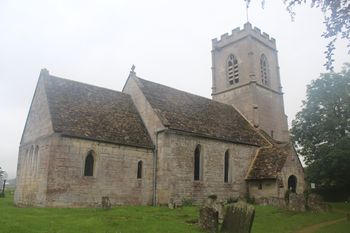St Margaret of Scotland, Whaddon, Gloucestershire: Archaeological evaluation (OASIS ID: urbanarc1-348490)
Chiz Harward, 2019. https://doi.org/10.5284/1057536. How to cite using this DOI
Data copyright © Chiz Harward unless otherwise stated
This work is licensed under a Creative Commons Attribution 4.0 International License.
Primary contact
Urban Archaeology
Unit 24D Daniels Industrial Estate
Bath Road
Stroud
Gloucestershire
GL5 3TJ
England
Resource identifiers
- ADS Collection: 3641
- DOI:https://doi.org/10.5284/1057536
- How to cite using this DOI
Introduction

On June 19th and 20th 2019 Urban Archaeology carried out an archaeological evaluation on the porch at the church of St Margaret, Whaddon, Gloucestershire, GL4 0UE, SO 83326 13677.
The porch is displaying ongoing signs of serious structural failings and investigation into the foundations and the soil conditions was required to inform any further action. Three test pits were excavated. Natural Lias Clay was located at a depth of 0.98m bpgl in a hand-auger hole in one test pit, this is appreciably deeper than natural clay seen in 2005 east of the church at 0.4m bpgl. Human bone immediately above the truncated surface of the Lias Clay suggests there is a burial at this location, with further human remains recovered from another hand auger hole. It is probable that burials predating the porch lie beneath its footprint.
The construction of the porch foundations is different on the east and west walls of the porch. Only a short length of the west foundation was exposed, but it had a small offset (0.04m) projecting from the superstructure face and the visible foundation was a roughly dressed block of limestone. By comparison the eastern wall foundation has an offset projecting up to 0.32m from the face of the superstructure, whilst the northern wall had a foundation projecting up to 0.6m. The northern and eastern foundations are formed of large blocks of limestone rubble, with no visible mortar. The cracks visible in the superstructure do not appear to continue into the foundation, with no obvious cracks or movement of the foundations. Concrete was poured into small pits which had been dug at each buttress, presumably to support the existing foundation which were left in situ but which were not underpinned.





